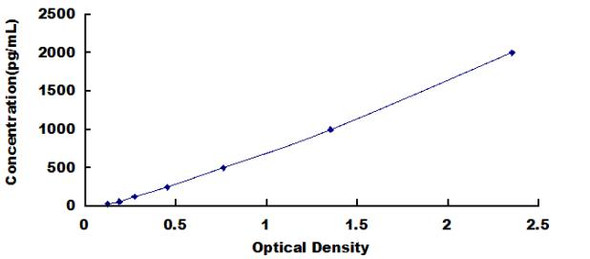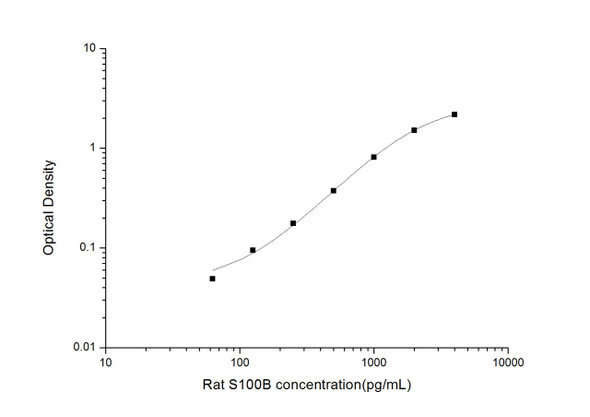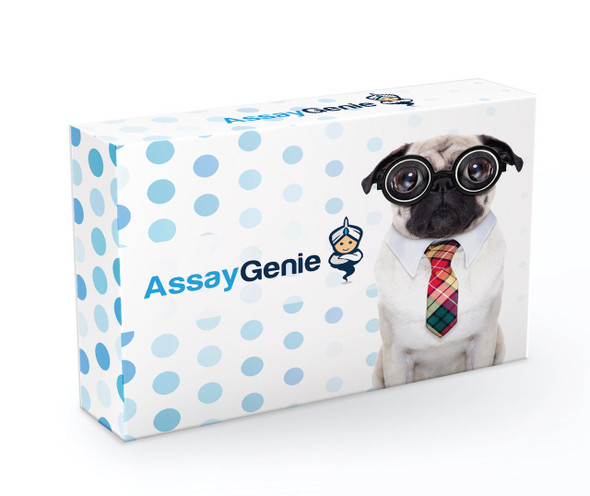Rat Signaling ELISA Kits 3
Rat S100B (S100 Calcium Binding Protein B) CLIA Kit (RTES00505)
- SKU:
- RTES00505
- Product Type:
- ELISA Kit
- ELISA Type:
- CLIA Kit
- Size:
- 96 Assays
- Sensitivity:
- 9.38pg/mL
- Range:
- 15.63-1000pg/mL
- ELISA Type:
- Sandwich
- Synonyms:
- S100-B, NEF, S100Beta
- Reactivity:
- Rat
- Sample Type:
- Serum, plasma and other biological fluids
Description
| Assay type: | Sandwich |
| Format: | 96T |
| Assay time: | 4.5h |
| Reactivity: | Rat |
| Detection method: | Chemiluminescence |
| Detection range: | 15.63-1000 pg/mL |
| Sensitivity: | 9.38 pg/mL |
| Sample volume: | 100µL |
| Sample type: | Serum, plasma and other biological fluids |
| Repeatability: | CV < 15% |
| Specificity: | This kit recognizes Rat S100B in samples. No significant cross-reactivity or interference between Rat S100B and analogues was observed. |
This kit uses Sandwich-CLIA as the method. The micro CLIA plate provided in this kit has been pre-coated with an antibody specific to Rat S100B. Standards or samples are added to the appropriate micro CLIA plate wells and combined with the specific antibody. Then a biotinylated detection antibody specific for Rat S100B and Avidin-Horseradish Peroxidase (HRP) conjugate are added to each micro plate well successively and incubated. Free components are washed away. The substrate solution is added to each well. Only those wells that contain Rat S100B, biotinylated detection antibody and Avidin-HRP conjugate will appear fluorescence. The Relative light unit (RLU) value is measured spectrophotometrically by the Chemiluminescence immunoassay analyzer. The RLU value is positively associated with the concentration of Rat S100B. The concentration of Rat S100B in the samples can be calculated by comparing the RLU of the samples to the standard curve.
| UniProt Protein Function: | S100B: Weakly binds calcium but binds zinc very tightly- distinct binding sites with different affinities exist for both ions on each monomer. Physiological concentrations of potassium ion antagonize the binding of both divalent cations, especially affecting high-affinity calcium-binding sites. Binds to and initiates the activation of STK38 by releasing autoinhibitory intramolecular interactions within the kinase. Interaction with AGER after myocardial infarction may play a role in myocyte apoptosis by activating ERK1/2 and p53/TP53 signaling. Dimer of either two alpha chains, or two beta chains, or one alpha and one beta chain. The S100B dimer binds two molecules of STK38. Interacts with AGER. The S100B dimer interacts with two molecules of CAPZA1. Although predominant among the water-soluble brain proteins, S100 is also found in a variety of other tissues. Belongs to the S-101 family. |
| UniProt Protein Details: | Protein type:Calcium-binding Cellular Component: cell soma; cytoplasm; extracellular space; intracellular membrane-bound organelle; nucleus; perinuclear region of cytoplasm; ruffle Molecular Function:calcium ion binding; calcium-dependent protein binding; identical protein binding; protein binding; protein homodimerization activity; RAGE receptor binding; receptor binding; tau protein binding; zinc ion binding Biological Process: astrocyte differentiation; learning and/or memory; memory; positive regulation of apoptosis; positive regulation of cell proliferation; positive regulation of I-kappaB kinase/NF-kappaB cascade; positive regulation of synaptic transmission; regulation of cell shape; regulation of neuronal synaptic plasticity; response to glucocorticoid stimulus; response to methylmercury |
| NCBI Summary: | binds GTPase activating protein IQGAP1; may play a role in cell membrane rearrangement [RGD, Feb 2006] |
| UniProt Code: | P04631 |
| NCBI GenInfo Identifier: | 6981498 |
| NCBI Gene ID: | 25742 |
| NCBI Accession: | NP_037323. 1 |
| UniProt Related Accession: | P04631 |
| Molecular Weight: | 10,744 Da |
| NCBI Full Name: | protein S100-B |
| NCBI Synonym Full Names: | S100 calcium binding protein B |
| NCBI Official Symbol: | S100b |
| NCBI Official Synonym Symbols: | S100P |
| NCBI Protein Information: | protein S100-B |
| UniProt Protein Name: | Protein S100-B |
| UniProt Synonym Protein Names: | S-100 protein beta chain; S-100 protein subunit beta; S100 calcium-binding protein B |
| Protein Family: | Protein |
| UniProt Gene Name: | S100b |
| UniProt Entry Name: | S100B_RAT |
As the RLU values of the standard curve may vary according to the conditions of the actual assay performance (e. g. operator, pipetting technique, washing technique or temperature effects), the operator should establish a standard curve for each test. Typical standard curve and data is provided below for reference only.
| Concentration (pg/mL) | RLU | Average | Corrected |
| 1000 | 49082 58268 | 53675 | 53650 |
| 500 | 21141 23837 | 22489 | 22464 |
| 250 | 10317 10105 | 10211 | 10186 |
| 125 | 4867 4935 | 4901 | 4876 |
| 62.5 | 2621 2285 | 2453 | 2428 |
| 31.25 | 1319 1243 | 1281 | 1256 |
| 15.63 | 667 749 | 708 | 683 |
| 0 | 25 25 | 25 | -- |
Precision
Intra-assay Precision (Precision within an assay): 3 samples with low, mid range and high level Rat S100B were tested 20 times on one plate, respectively.
Inter-assay Precision (Precision between assays): 3 samples with low, mid range and high level Rat S100B were tested on 3 different plates, 20 replicates in each plate.
| Intra-assay Precision | Inter-assay Precision | |||||
| Sample | 1 | 2 | 3 | 1 | 2 | 3 |
| n | 20 | 20 | 20 | 20 | 20 | 20 |
| Mean (pg/mL) | 52.59 | 127.89 | 371.75 | 50.75 | 127.49 | 385.21 |
| Standard deviation | 6.82 | 14.00 | 23.57 | 6.35 | 13.09 | 33.78 |
| C V (%) | 12.97 | 10.95 | 6.34 | 12.51 | 10.27 | 8.77 |
Recovery
The recovery of Rat S100B spiked at three different levels in samples throughout the range of the assay was evaluated in various matrices.
| Sample Type | Range (%) | Average Recovery (%) |
| Serum (n=5) | 89-106 | 97 |
| EDTA plasma (n=5) | 96-110 | 102 |
| Cell culture media (n=5) | 98-112 | 104 |
Linearity
Samples were spiked with high concentrations of Rat S100B and diluted with Reference Standard & Sample Diluent to produce samples with values within the range of the assay.
| Serum (n=5) | EDTA plasma (n=5) | Cell culture media (n=5) | ||
| 1:2 | Range (%) | 90-101 | 95-110 | 88-101 |
| Average (%) | 95 | 101 | 94 | |
| 1:4 | Range (%) | 103-118 | 92-108 | 89-100 |
| Average (%) | 110 | 99 | 94 | |
| 1:8 | Range (%) | 99-113 | 90-105 | 93-106 |
| Average (%) | 106 | 96 | 100 | |
| 1:16 | Range (%) | 90-106 | 86-100 | 95-106 |
| Average (%) | 97 | 93 | 100 |
An unopened kit can be stored at 4°C for 1 month. If the kit is not used within 1 month, store the items separately according to the following conditions once the kit is received.
| Item | Specifications | Storage |
| Micro CLIA Plate(Dismountable) | 8 wells ×12 strips | -20°C, 6 months |
| Reference Standard | 2 vials | |
| Concentrated Biotinylated Detection Ab (100×) | 1 vial, 120 µL | |
| Concentrated HRP Conjugate (100×) | 1 vial, 120 µL | -20°C(shading light), 6 months |
| Reference Standard & Sample Diluent | 1 vial, 20 mL | 4°C, 6 months |
| Biotinylated Detection Ab Diluent | 1 vial, 14 mL | |
| HRP Conjugate Diluent | 1 vial, 14 mL | |
| Concentrated Wash Buffer (25×) | 1 vial, 30 mL | |
| Substrate Reagent A | 1 vial, 5 mL | 4°C (shading light) |
| Substrate Reagent B | 1 vial, 5 mL | 4°C (shading light) |
| Plate Sealer | 5 pieces | |
| Product Description | 1 copy | |
| Certificate of Analysis | 1 copy |
- Set standard, test sample and control (zero) wells on the pre-coated plate and record theirpositions. It is recommended to measure each standard and sample in duplicate. Note: addall solutions to the bottom of the plate wells while avoiding contact with the well walls. Ensuresolutions do not foam when adding to the wells.
- Aliquot 100 µL of standard solutions into the standard wells.
- Add 100 µL of Sample / Standard dilution buffer into the control (zero) well.
- Add 100 µL of properly diluted sample (serum, plasma, tissue homogenates and otherbiological fluids. ) into test sample wells.
- Cover the plate with the sealer provided in the kit and incubate for 90 min at 37 °C.
- Aspirate the liquid from each well, do not wash. Immediately add 100 µL of BiotinylatedDetection Ab working solution to each well. Cover the plate with a plate seal and gently mix. Incubate for 1 hour at 37 °C.
- Aspirate or decant the solution from the plate and add 350 µL of wash buffer to each welland incubate for 1-2 minutes at room temperature. Aspirate the solution from each well andclap the plate on absorbent filter paper to dry. Repeat this process 3 times. Note: a microplatewasher can be used in this step and other wash steps.
- Add 100 µL of HRP Conjugate working solution to each well. Cover with a plate seal andincubate for 30 min at 37 °C.
- Aspirate or decant the solution from each well. Repeat the wash process for five times asconducted in step 7.
- Add 100 µL of Substrate mixture solution to each well. Cover with a new plate seal andincubate for no more than 5 min at 37 °C. Protect the plate from light.
- Determine the RLU value of each well immediately.






